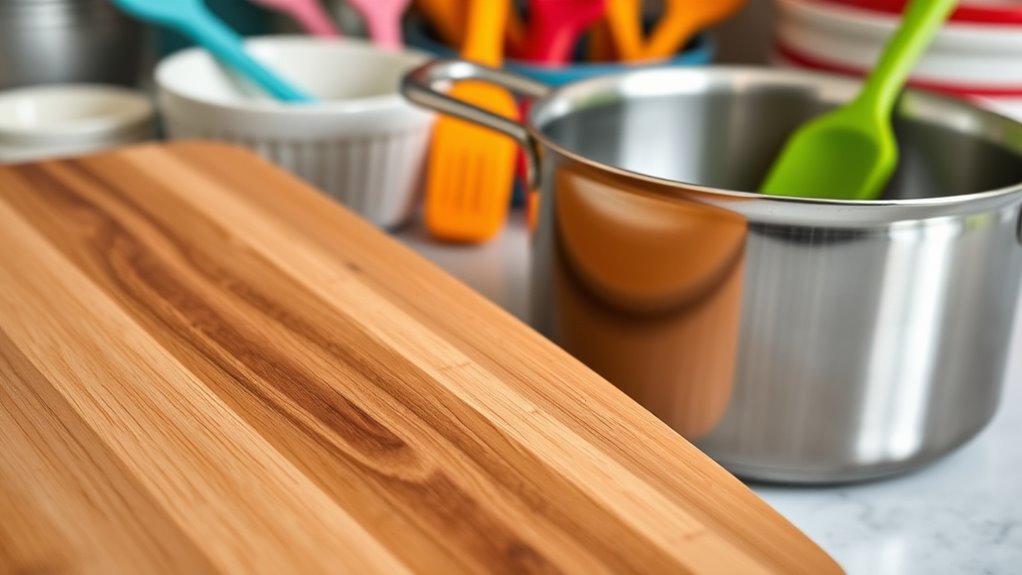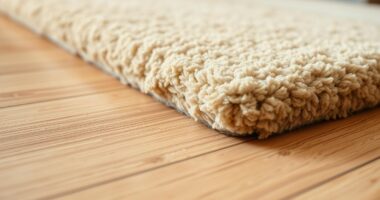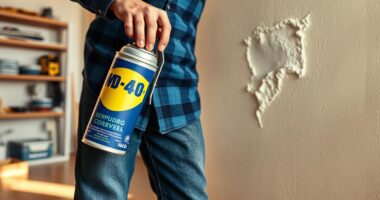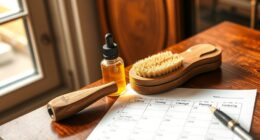To choose a food-safe finish for your kitchenware, you should consider natural oils like mineral or tung oil, which penetrate deeply and provide moisture resistance. Sealers and wax blends add durability and a glossy look, but require maintenance. Always guarantee finishes are FDA-approved, non-toxic, and properly applied with proper curing times. If you want to learn more about techniques, safety tips, and maintenance, there’s plenty more to discover to keep your kitchenware safe and durable.
Key Takeaways
- Food-safe finishes prevent bacterial growth, moisture absorption, and cracking, ensuring hygiene and durability of kitchenware.
- Common food-safe finishes include mineral oil, tung oil, and wax blends, each offering different levels of protection and maintenance.
- Proper surface preparation, application, curing, and regular reapplication are essential for effective and safe finishing.
- Always use FDA-approved, non-toxic, VOC-free finishes and wear protective gear during application.
- Regular maintenance and testing, such as thumbprint checks, ensure the longevity and safety of the finish.
Understanding the Importance of Food-Safe Finishes
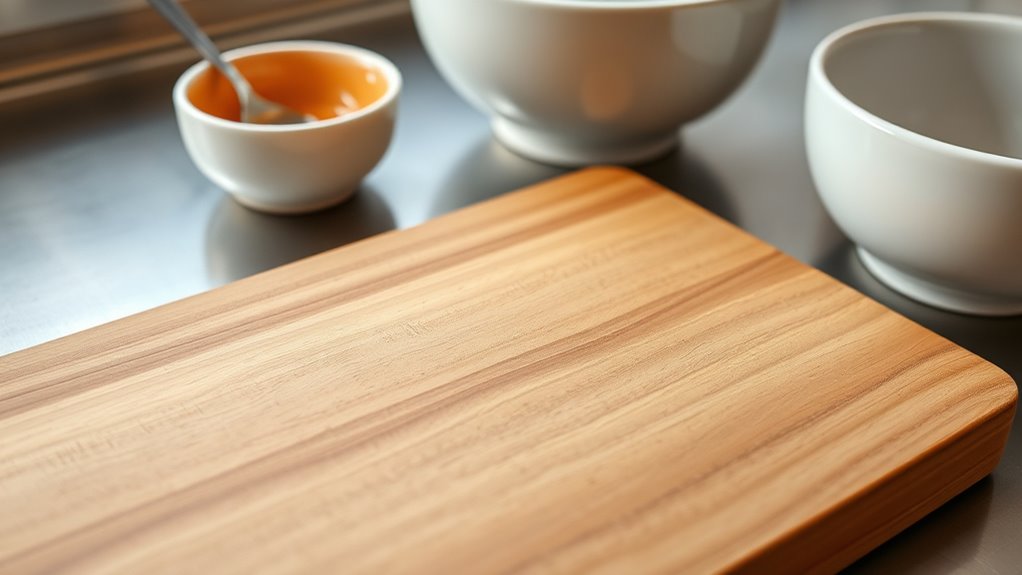
Understanding the importance of food-safe finishes is essential for ensuring your kitchenware remains safe and functional. These finishes prevent bacterial growth by sealing the wood, making it easier to clean and reducing the risk of contamination. They also limit moisture absorption, which helps maintain the wood’s integrity and prevents cracking or warping over time. Applying food-safe finishes enhances the durability of your tools, protecting them from wear and tear, so they last longer. Sealed surfaces are simpler to clean, lowering health risks associated with unsealed wood that can harbor bacteria. Additionally, food-safe finishes preserve the aesthetic appeal of your kitchenware, keeping them looking new. Using finishes that are compatible with essential oils for food safety ensures your kitchenware remains safe for food contact and resistant to potential bacterial contamination. Incorporating proper curing techniques can further improve the longevity and safety of your finished kitchenware. Regular maintenance and reapplication of finishes as needed will help maintain a safe and attractive surface over time, extending the lifespan of your kitchen tools. Employing proper application methods can significantly influence the effectiveness and safety of the finishes you choose. Proper application and maintenance of these finishes are crucial for long-term safety and effectiveness.
Exploring Common Types of Food-Safe Finishes
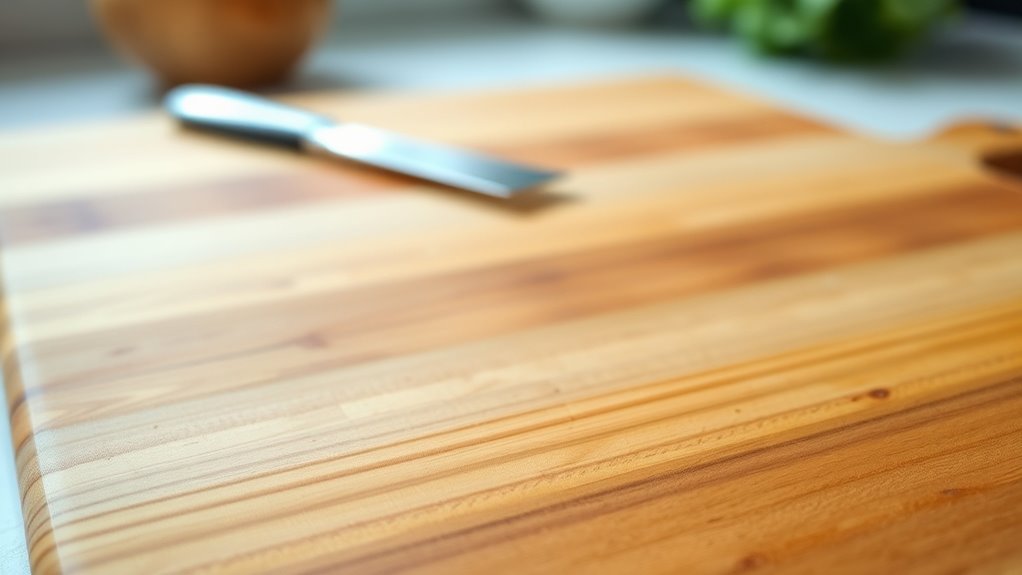
When selecting food-safe finishes for your kitchenware, it’s important to know the most common options and their specific benefits. Mineral oil is inexpensive, non-toxic, and ideal for cutting boards and utensils; it prevents wood from drying and cracking but needs frequent reapplication. Silky finishes can enhance the appearance while maintaining safety, making them a popular choice among DIY enthusiasts. Danish oil combines oil and varnish, offering moderate water resistance and enhancing wood grain, suitable for countertops and furniture. Butcher block oil, made with mineral oil and waxes, penetrates deeply to protect high-traffic surfaces and resists bacteria when maintained properly. Walnut oil provides a natural matte finish, great for bowls, but requires thorough curing. Food-safe polyurethane creates a durable, water-resistant film for countertops but needs long curing time. Tung oil and beeswax blends also offer water resistance, suitable for various kitchen items. Proper surface preparation is essential to ensure the finish adheres well and provides the best protection for your kitchenware.
Benefits of Different Finishing Options
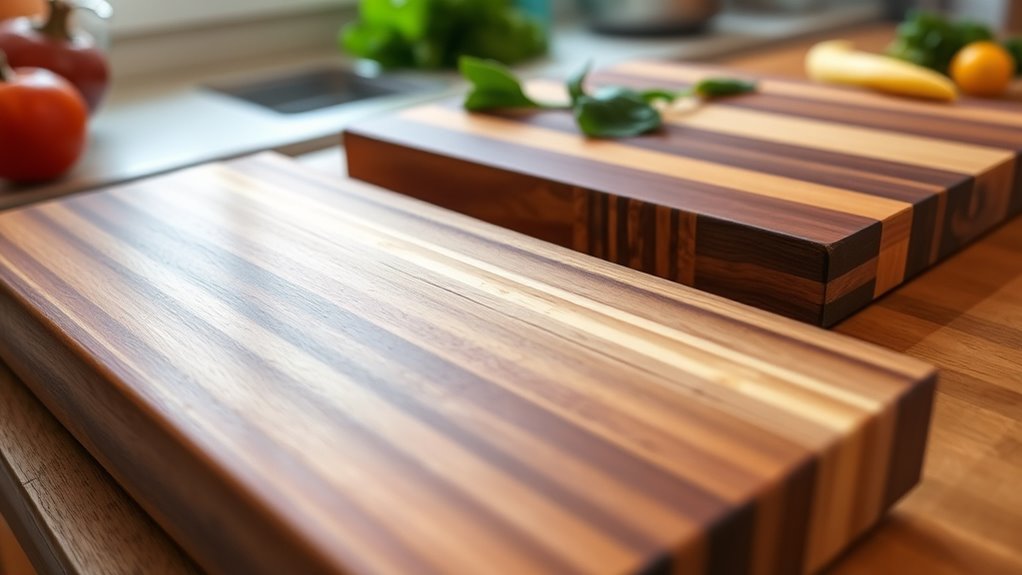
Different finishing options for kitchenware offer distinct benefits that enhance both functionality and safety. Food-safe finishes create a barrier that prevents moisture absorption, reducing swelling and cracking, while also blocking food particles and lowering bacterial growth risks. Recognizing the importance of food safety in kitchenware, sealing with these finishes makes cleaning easier and more effective, helping your tools stay in good condition longer. Incorporating proper organization techniques can further extend the lifespan of your kitchenware by maintaining a clutter-free environment. Natural oils like walnut oil penetrate deeply, enriching the wood grain and providing organic protection. Additionally, surface sealers form a durable film that resists wear and tear. Both options help prevent drying, cracking, and discoloration, extending the lifespan of your kitchenware. Understanding finishing techniques and using FDA-approved, non-toxic finishes guarantees safe, tasteless contact with food, giving you confidence in your tools’ safety and quality. Regular maintenance and understanding food-safe finishes can also contribute to improved hygiene and durability over time.
Step-by-Step Application Techniques
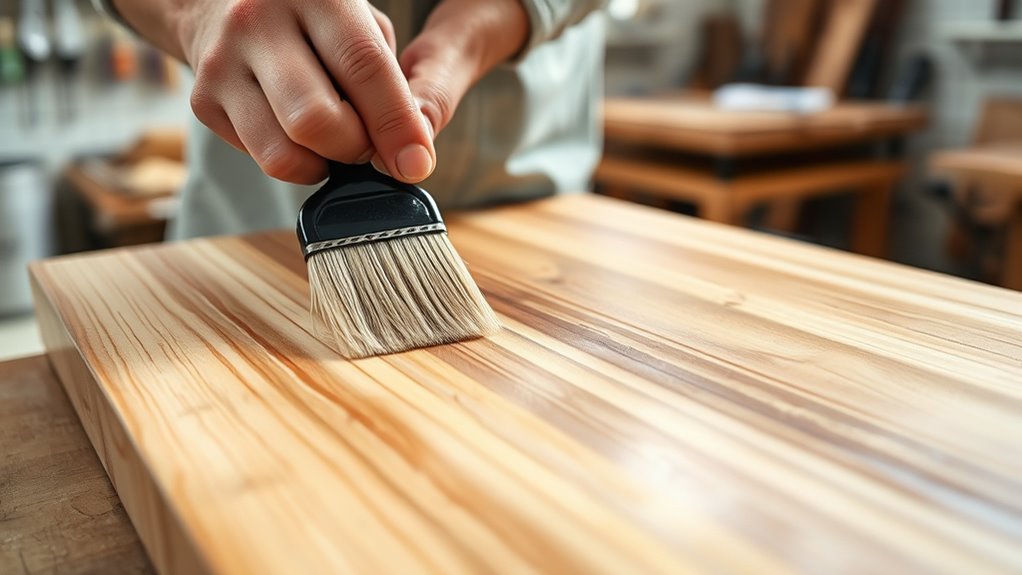
To guarantee a smooth and effective finishing process on your kitchenware, start with proper surface preparation. Sand the wood to 220–320 grit to ensure a smooth surface, removing tool marks and imperfections. Clean off dust with compressed air, a tack cloth, or a vacuum. Proper surface preparation is essential for achieving optimal adhesion and a professional appearance. If there are burn marks or engravings, hand-sand them for clarity. For bowls, sand in both directions on the lathe for even texture. Before applying any finish, inspect the surface carefully to confirm it’s free of debris, residue, or uneven spots. Additionally, using a food-safe finish ensures that the coating remains safe for kitchen use while providing durability. Incorporating quality finishes that are approved for food contact helps prevent contamination and ensures safety. Proper preparation creates a clean, smooth base that promotes better adhesion and a professional-looking finish. Using the right wood finish products can also enhance the durability and appearance of your kitchenware. Ensuring the surface is free of contaminants and properly prepared aligns with wood stove safety standards, which emphasize the importance of a secure and stable working environment. Taking these steps ensures your food-safe finish will bond well and look great on your kitchenware.
Safety Precautions When Using Food-Safe Finishes

Using food-safe finishes requires careful attention to safety precautions to protect yourself and make sure your kitchenware remains safe for food contact. Always use finishes approved by the FDA to ensure compliance with safety standards. Avoid products containing lead, formaldehyde, or VOCs, which can leach chemicals into food. Verify finish certifications through manufacturer documentation or third-party testing. During application, wear nitrile gloves and work in well-ventilated areas to prevent skin absorption and inhalation of fumes. Use dedicated tools to avoid cross-contamination and keep finishes away from food prep zones. Properly dispose of rags and materials to prevent fire hazards. Follow curing times precisely, and check for fully cured surfaces with the thumbprint test before use. Understanding the importance of food contact safety helps maintain a healthy kitchen environment. These precautions help ensure safety and durability. Additionally, ensuring proper finish curing is crucial for long-term safety and effectiveness in food-related applications. Being aware of AI advancements in related industries highlights the ongoing importance of safety and innovation in product development. Incorporating regulatory compliance practices ensures that your finishes meet industry standards and protect consumer health.
Comparing Popular Finishing Choices

When choosing a finishing method for your wooden kitchenware, it’s important to contemplate how each option balances safety, durability, and ease of maintenance. Mineral oil is popular for its ease of use and safety, but it needs frequent reapplication since it doesn’t harden or cure. Tung oil, especially pure or polymerized, provides superior moisture and heat resistance, making it ideal for kitchen tools. Additionally, Honda Tuning techniques such as ECU remapping and exhaust upgrades can be applied to optimize the performance of your finishing process, ensuring better protection and longevity. Wax blends add a glossy, protective layer but require regular touch-ups. Surface sealers, like wax over oils, combine deep protection with easier maintenance. Your choice depends on your priorities for longevity, safety, and how much upkeep you’re willing to do.
Frequently Asked Questions
How Often Should Food-Safe Finishes Be Reapplied on Kitchenware?
You’re wondering how often to reapply food-safe finishes on your kitchenware. The frequency depends on usage, type of finish, and environmental conditions.
Mineral oil needs reapplication every few weeks, while more durable options like walnut oil last longer. Regularly check for dryness, dullness, or cracks.
Reapply when you notice these signs, ensuring surfaces stay protected and safe. Keep the surface clean and dry before reapplying for best results.
Are There Any Finishes Suitable for Metal Kitchen Tools?
When considering finishes for metal kitchen tools, you should look for options that guarantee safety and durability. Electropolishing is a great choice because it creates a smooth, corrosion-resistant surface without additional coatings, making it safe for food contact.
Food-safe oils like mineral oil or tung oil can also be applied to protect the surface. Avoid unsafe paints or coatings, and always select finishes proven for food-grade applications for your tools.
Can Food-Safe Finishes Be Used on Outdoor Wooden Furniture?
Imagine putting sunscreen on a beach umbrella—it’s meant to protect, but won’t last forever in the sun. Similarly, food-safe finishes aren’t designed for outdoor durability. You can use them indoors safely, but outdoors, they degrade quickly under weather.
For outdoor furniture, opt for marine varnish or weather-resistant stains. Food-safe finishes alone won’t withstand rain or sun, so prioritize durability for outdoor use.
What Are the Signs That a Finish Has Degraded or Become Unsafe?
You should watch for signs that your finish has degraded or become unsafe. If you notice peeling, chipping, or cracking, it indicates wear and potential hazards.
Discoloration, rust spots, or a persistent sticky film also signal deterioration.
Food sticking or uneven heating are functional clues that the finish is compromised.
Additionally, if smells develop or cleaning becomes difficult, it’s a sign the finish may be unsafe for continued use.
Are There Any Food-Safe Finishes That Resist Staining and Odors?
You’re wondering if any food-safe finishes resist staining and odors. Yes, some options like food-safe polyurethane offer excellent stain resistance and remain odorless once cured.
Carnauba wax and beeswax can also add extra stain resistance when layered over oils. Keep in mind, regular maintenance helps keep these finishes effective.
Choosing the right finish depends on your needs for durability, stain resistance, and odor control, so consider each option carefully.
Conclusion
As you finish your kitchenware, imagine your creations glowing with a smooth, lustrous finish, ready to be touched and tasted. Choosing the right food-safe finish not only protects your pieces but also guarantees every meal you prepare is safe and delicious. With careful application and safety precautions, your handcrafted items become both beautiful and trustworthy. So, embrace the process, and let your culinary tools shine with confidence and craftsmanship.
